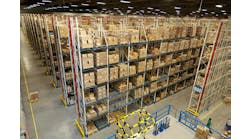The supply chain is often viewed as a consumer of cash—at the supplier level, in transit, in production facilities and in warehouses. Companies continually wish to reduce the amount of inventory in their operations. The University of Tennessee's "Game-Changing Trends in Supply Chain" reveals that as much as 60% of companies' costs are in their supply chains. Opposing demands are those of customer satisfaction and business competitiveness, of which one mandate is having sufficient inventory on hand to meet customer demand for immediate shipments.
These contradictory inputs result in inventory having to be held—somewhere—in sufficient quantities to maintain customer satisfaction. If on-hand inventory is minimized, the consequence is that these stresses are pushed into the supply chain. They become Supply Chain Inventory Stress.
These stresses are broadly split into three, which are somewhat connected: timeliness of delivery, quality of goods and who owns the goods at each stage.
Timely Delivery
For many supply chain owners, the first sight of their expected product is notification that the product is available for pick-up, or is loaded onto containers. Assurances of timeliness may have been given; the particular supplier may have a good overall record; the contract over time may have increased the penalties on the supplier for failing to meet required dates. All of these are nice, except when the shipment is late.
The costs of this vary: they might be missed revenue for seasonal goods; perhaps the recipient's JIT production run can't occur when expected, with a resulting shift in planning (is the inventory ready for the plan B?). Shipments going to big-box retailers may incur penalties, deliveries may be refused or business loss may be threatened. Avoiding these creates other costs, one of the biggest being that of expedited freight—a cost often not discretely captured.
Quality of Goods
Some portion of in-transit inventory is also in a nebulous state—its quality level is undiscovered yet, with the potential for re-work costs and attendant consequence of untimeliness. Inventory in transit which is not useful needs to be re-worked, similar to work in process which hasn't emerged as finished goods. However, it's going to cost more than usual. While the costs of repair and the associated delays might be pushed back to the supplier, with the usual arguments over the terms of the contract, it is still going to be late, with the results being unhappy customers, penalties or missed revenues.
IBM's Global Chief Supply Chain Officer study indicates that 65% of companies experience unreliable delivery, and (separately) 61% experience poor quality in their shipped goods.
Who Owns It?
The third factor is who owns the inventory. An example from one end of the spectrum is that of supplier-owned inventory, often when supply chain owners wish to reduce net working capital. If a buyer has sufficient leverage over its supply base, and if the supply base is financially strong enough to absorb the financial impact, this can work quite well.
As supply chain risk becomes more and more understood, it is more obvious that many suppliers are in the "small to medium enterprise" category. These SMEs often don't have the financial wherewithal to extend inventory financing until the inventory is sold in the recipient country. Indeed, they may struggle with payment terms that withhold payment until the goods are inspected as part of receiving.
The fiscal consequences of poor timeliness or quality can often be shifted back to the supplier through reinforcement of the contract terms. While helpful to be able to recover direct costs, this doesn't make up for loss of customer satisfaction, competitiveness or those incurred in grey areas, such as the loss of JIT production capacity.
Coping Strategies
Two ways to manage these risks are by having multiple suppliers for the same items, or having additional inventory on hand. The set of costs of additional suppliers—less volume to discount, overseeing another supplier with the associated supply chain—or of having more inventory on hand need to be weighed against the costs of timeliness and quality of the existing supplier set.
A third way is to analyze the supplier network, categorizing suppliers into risk groups, for example those with low risk of poor quality, and then assigning resources as needed.
All of this changes if the supply chain owner knows earlier what is coming, whether it will meet the desired ship date and whether its quality meets requirements.
If incoming supply of goods is both timely and of high quality, how much inventory can be permanently eliminated from the supply chain?
Information Flow is Essential
ERP systems start with in-house functions, capture manufacturing and distribution data, and perhaps a transportation link. There are now many fine transportation management system (TMS) software packages that bring visibility all the way to the supplier's door. Taking purchase order information and translating it into dock-door information creates cost-and-delivery efficiencies even as supply chains become more complex.
These still take suppliers' "outputs" of information and goods, after the ability to influence them or react to in-production milestones have been missed. For true supply chain visibility, seeing inside suppliers is essential.
Tools for visibility into suppliers are becoming available: these break down the [supplier] walls to knowledge. Information can flow from the earliest part of the supply chain, bringing trust-through-verification and the ability to be alerted and to react to unplanned events.
Today's technologies and instant transmissibility of information bring "reach" into suppliers, so that information is gathered directly at the source. The wall of visibility moves from suppliers' dock doors to the production line, assembly cells and packaging.
The effect of this deeper visibility into the supply chain is to move the information boundary to a new frontier. If there is high quality information flow from the earliest part of the supply chain, companies have the ability to react to production delays or quality levels much earlier. They also have the confidence that a particular delivery is both on time and of suitable quality. Risk mitigation inventory can be eliminated. The planned JIT production line can be set up for the day's run, in confidence and at the lowest cost.
Visibility Tools
Tablet computers now gather objective data right at the source, through direct measurement of the results of discrete production events.
On-board cameras, allied to software, give direct, documented visibility into incorrect production results.
Intelligent connectability between machinery and measuring devices transforms localized data into global decision-ready information.
The ability to dictate the required steps from afar brings a structured information flow to processes, guaranteeing that short-cuts cannot be taken. The confirmation of proper timeliness and quality brings confidence throughout the supply chain; the visibility into steps which are not occurring in a timely fashion, or not producing the required level of quality, bring the ability for corrective action to occur at the earliest, least-cost point.
Setting an Example
With today's instant communicability and data flow through the cloud, an in-production action step in an Asian factory updates supply chain dashboard tools in the U.S. within seconds. Both supply chain owner and supplier benefit —together and separately—from the ability to immediately identify anomalies. Toy manufacturing suppliers have experienced a 60% reduction in quality compliance labor costs, and reduced costs of correction as corrections occur at the lowest cost point. Industrial equipment manufacturers have eliminated labor for incoming quality assurance, and reduce "just in case" inventory for JIT operations. Consumer goods companies experienced reduced losses due to timely deliveries of highly seasonal goods and reduced big-box compliance costs. Both benefit from minimized schedule impact and both benefit from minimizing claims management.
This new technology approach brings benefits to operators of today's complex supply chains. Having confidence through verification at the supplier level offers the opportunity to optimize the amount of inventory in the supply chain. It offers the ability to review those hidden stores of inventory, and release money for more useful purposes—with the knowledge that customer demands will still be met, and at the lowest cost. Information quality and timeliness translate into inventory quality and timeliness.
Colman Roche is executive vice president at Pivot88, providers of supply chain execution software. His background includes optimizing manufacturing and distribution supply chains. He has an MBA from Rutgers University and executive leadership from Harvard Business School.



